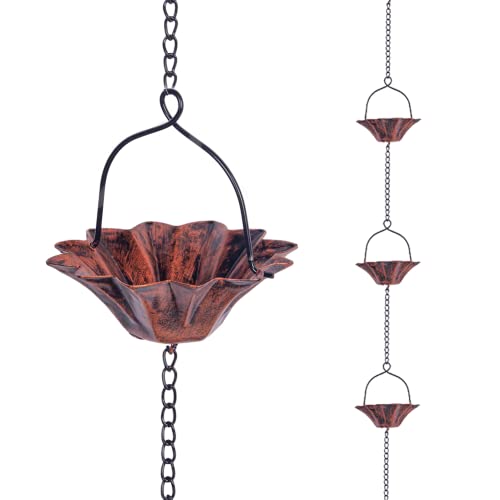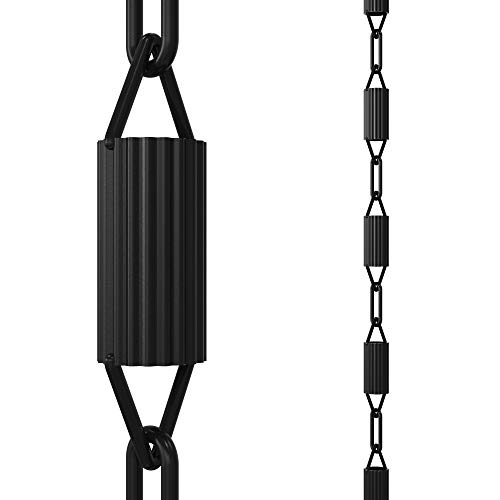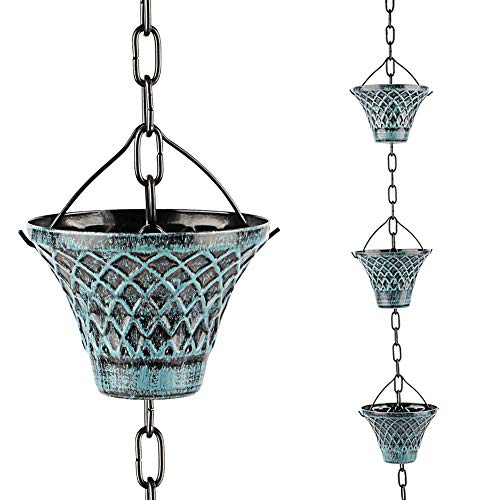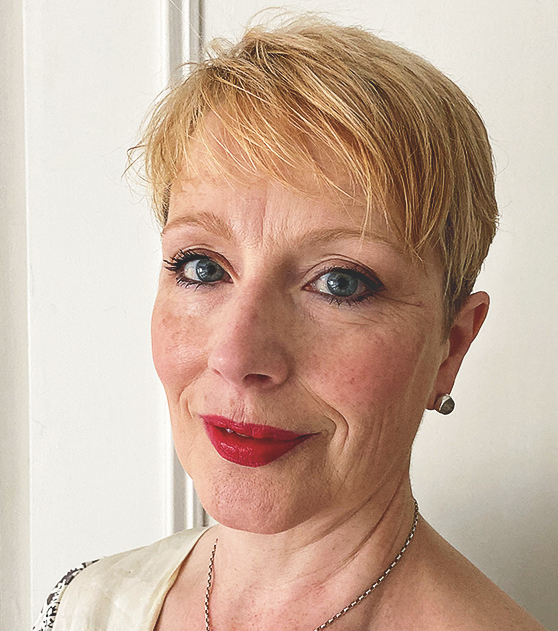What is a rain chain? Find out why this sustainable alternative to a downpipe is more than just decorative
Add a Japanese-inspired touch to your backyard, and channel water to where your garden needs it most


You may have seen a metal chain or ornamental links hanging from a gutter and wondered what they do. Known as rain chains, they're not simply decoration, although they do add a visual and auditory dimension to the garden that can enhance your experience of being in your backyard.
In fact, rain chains serve are incredibly useful to help achieve sustainable rainwater harvesting in your backyard. They direct rain water from roofs and gutters and can channel it to where it is most needed in the garden. A rain chain can divert rain water to a water butt, into a bed of moisture-loving plants, or into the ground where it can be used to replenish the water table .
There are many great reasons to install a rain chain. If you're looking for ideas that tackle drought or take a more climate-friendly approach to gardening – such as a rain garden – this is an idea worth exploring. I am always on the hunt for more sustainable ways to garden, and have found using a rain chain is simply a good way of watering plants effectively by tapping into our natural resources and avoiding wasting water. We take a closer look at what rain water chains are, how they work, and how you can get the very best out of them in your own backyard.

What is a rain chain – and how to get the most from it
Rain chains have been on-trend additions to our yards for a few years now, but they are by no means a new invention. They originate from ancient Japan, where they were used as a means to collect rain water – and you can still find them in Japanese homes and gardens today.
Known in Japan as 'kusari doi', which means rain gutter, rain chains are attached to the eaves or gutters of a house in place of a downpipe.
When it rains, the water gently flows down the rain chain - often in the form of decorative rain bells or cups - to the bottom, where it can be collected in a barrel or decorative water feature, or channelled into an area of your backyard for localized irrigation.
A rain chain can be as simple as a salvaged heavy chain. This look works well when you're thinking of rustic, decorative features to complement country garden ideas.
Design expertise in your inbox – from inspiring decorating ideas and beautiful celebrity homes to practical gardening advice and shopping round-ups.
You can also buy decorative rain chains, made from ornamental links, cups and shaped metal, which add an element of design to their function. We have compiled a fantastic list of the best rain chains to buy to inspire you.
In some cases, rain chains can be better than downspouts and are an integral part of sustainable garden ideas as they make collecting water easy.
How does a rain chain work?
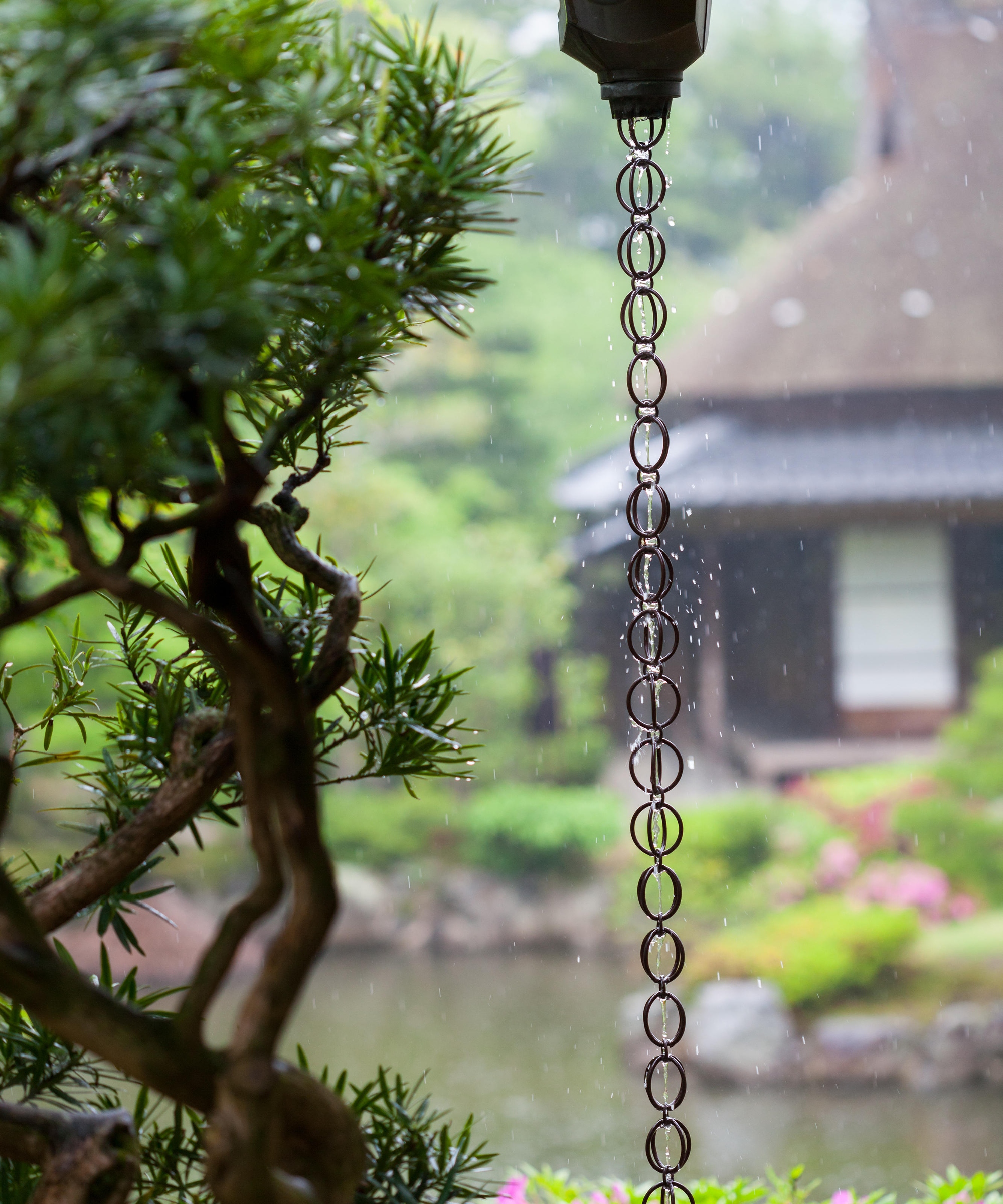
A rain chain should be placed at the corner of gutter, where a downpipe would usually be. That might be on the eaves of your house, on your shed or a garden building, or on your garage.
'Rain chains work in exactly the same way as a downpipe, but they help to slow the flow of rainwater, leading to a lesser risk of flooding in the drainage system and in your yard,' says Rachel Bull, head of gardens at H&G.
'As well as being sustainable and beneficial for the environment, gutter chains can help to make functional spaces more attractive by replacing less aesthetically pleasing downspouts with pretty rain bells or chains in a variety of designs.
'You can factor them into the design of your driveway, garden landscaping ideas, and patio ideas – any part of your front or backyard that would usually feature a lot of hard landscaping.'
At the base of a rain chain, it's possible to directs rainwater through the soil and back into the water table, by adding beds of moisture-loving perennials around paved surfaces. You can also plant groundcovers and creeping perennials between paving stones to allow rainwater to drain through the soil.

Rachel is a gardening editor, flower grower and floral designer. Her journalism career began on Country Living magazine, sparking a love of container gardening and wild planting. After more than a decade writing for and editing a range of consumer, business and special interest titles, Rachel became editor of floral art magazine The Flower Arranger. She then trained and worked as a floral designer and stylist in London for six years, before joining the Homes & Gardens team.
How to use a rain chain to water flower beds

If you don't collect the water in a decorative barrel or butt, you can allow the rainwater chain to reach a flower bed, especially if the roof line or eaves shelter the ground beside the house from the rain. This way, you're effectively irrigating the bed directly each time it rains.
Dig a small depression in the ground where the rain chain meets the soil, and line this with stones or pebbles, which will improve drainage and prevent the area becoming waterlogged. You can plant moisture-loving plants in and around the hole, with drought-resistant plants further away, where the rainwater is less likely to penetrate.
It's a good idea to secure the rain chain to the ground using a rain chain anchor stake or pin, such as this Monarch anchor stake from Amazon, to ensure it doesn't fly around and cause damage or injury in high winds. Or you could also use an anchor basin, which will weigh the chain down and prevent too much movement.
How to collect rainwater using a rain chain

Alternatively, you can use the rain chain to harvest rainwater, letting it drip into a barrel or water butt, such as this one from Amazon, or even into a fountain or water feature.
'If you let the rain chain dangle just above the top of the barrel, you'll be able to hear the sound of the water as it drips into the barrel, which can add a lovely sensory element to your garden and could also help to contribute to mindful gardening,' says Rachel.
It is easy to adjust the length of your rain chain downspout, simply by adding or removing links or decorative designs as needed. You can also buy additional sections of chain, though it is worth measuring the length you require before you buy.
If you decide to channel your chain into a water feature or barrel, you will need to anchor it securely to avoid movement and potential damage to anything nearby.
Shop rain chains
FAQs
Where is the best place to hang a rain chain?
Rain chains are installed where traditional downspouts would usually be on a house, garage or shed - at the end of a horizontal gutter pipe. Most properties have more than one downspout, so if you're thinking about the best place to hang one, consider where you will see or hear it the most. Rainwater chains are often chosen for their aesthetic value, and have the added bonus of creating a relaxing sound from the trickling flow of the water.
Do rain chains freeze in the winter?
In particularly cold climates, or during times of prolonged cold snaps, rain chains can indeed freeze in winter. Usually, this does not present too much of a problem, and they can look very beautiful with ice and frost glistening on the chain links. However, if the rain bells become too heavy they can present a danger to your property and to you, should they fall under the weight of the frozen water.
Before and during the winter, check to make sure your rain chain is installed properly and securely, and doesn't risk damage to a weak or unstable roof. It might be a good idea to take your rainwater chain down if you experience particularly harsh winters with freezing temperatures and high winds.
If this has inspired you to think about rainwater harvesting differently in your yard, you might want to know when is best water plants in order to use this vital resource most effectively.
Andrea has been immersed in the world of homes, interiors and lifestyle since her first job in journalism, on Ideal Home. She went from women's magazine Options to Frank. From there it was on to the launch of Red magazine, where she stayed for 10 years and became Assistant Editor. She then shifted into freelancing, and spent 14 years writing for everyone from The Telegraph to The Sunday Times, Livingetc, Stylist and Woman & Home. She was then offered the job as Editor on Country Homes & Interiors, and now combines that role with writing for sister title homesandgardens.com.
